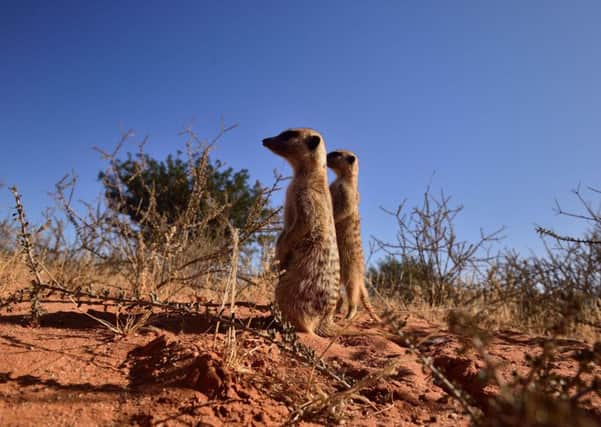Travel review: Botanical delights of South Africa's Northern Cape


It’s mid-morning and heat from the sun is transforming a rugged South African landscape into a spectacular nature show, as thousands of daises and flowering succulents open their petals to form a vast brilliantly-coloured living carpet.
This is my first glimpse of the world-famous wild flowers of remote Namaqualand, an area stretching 1,000km along the West Coast and into Namibia.
Advertisement
Hide AdAdvertisement
Hide AdA recognised biodiversity hotspot in the Northern Cape (the country’s largest and least populated province), a kaleidoscope of blooms burst from the sand and granite here each spring.
Their survival, always an against-the-odds battle with the harsh climate in this arid, semi-desert area, is even more remarkable now as the Northern Cape, along with other parts of this nation, has been in the grip of a persistent drought for four years.
“Our bloom show is always what we call our annual miracle. We particularly appreciate it at the moment, as it’s continuing despite the drop in rainfall levels,” says my guide Malcolm Mostert, as we gaze at a dazzling vista of fuschia pink, yellow and orange flowers in Goegap Nature Reserve.
It boasts 600 plant species and 45 mammals, including savanna baboons, and is in the heart of ‘‘bloom country’’ around 15km south-east of Springbok, the largest town in Namaqualand.
Advertisement
Hide AdAdvertisement
Hide Ad“Winter rain is vital to nourish the seeds of the plants which lie dormant in the soil during the dry months and so, of course, flower displays are affected but they’re still so beautiful,” Mostert explains.
Mostert takes guests from his Okiep Country Hotel, near Springbok, on tours to discover plant and abundant wildlife, to meet descendants of the (San) Bushmen tribe and experience homespun hospitality at Pedroskloof sheep farm, nestling at the foot of the nearby Kamieskroon Mountains.
It’s just a small taste of what’s on offer in this wonderful area, with its majestic backdrop of towering mountains, hills, granite outcrops and seemingly endless blue skies. Yet plants are undoubtedly a main draw.
Tourists, including botanists, ecologists and avid gardeners, visit throughout the year, especially during the flowering season from July to mid-September, because Namaqualand boasts around 3,500 plant species, as well as one third of the world’s succulent species.
Advertisement
Hide AdAdvertisement
Hide AdThere’s even a dedicated telephone hotline for ‘‘bloom hunters’’ giving flower location hotspots and flower sighting updates along the Namaqua Flower Trail.
Species include the Namaqualand daisy (dimorphotheca sinuata) as well as arctotis, asters, gazanias and osteospermum, and flowering succulents such as cheiridopsis, carpobrotus and crassula. Remarkably, in such unforgiving territory, there are trees too. Quivers (kokerboom) with water-storing leaves and shallow roots take advantage of every drop of moisture.
Drawn by the lure of refreshing sea breezes, shipwrecks, whale and dolphin spotting, as well as pristine beaches, I head north-west to the Diamond Coast.
In the 1800s, diamonds discovered in the Northern Cape laid the foundation for South Africa’s economy. Mining focused on the seabed so this coast, previously a restricted area and still owned by mining corporations, was for decades left untouched and unspoilt.
Advertisement
Hide AdAdvertisement
Hide AdMy guide, Rodville Adams, takes tours between Koingnaas and Kleinzee, covering coast and country, and describes it as a place to “refresh the soul and bathe in nature”. The only noise is the barking of seals – colonies of Cape fur seals bask on rocky outlets and squabble for territory during the mating season (September to October) – to the accompaniment of the whistling cry of the Cape long-billed lark and the crashing Atlantic waves.
There is one sign of man’s incursion – the metal skeletons of three wrecks, The Piratiny, Border and Arosa, jutting from the sand, which is littered with shells and even an occasional whale bone.
The area is, says Adams, fast becoming a tranquil refuge for those seeking to escape the stresses of modern life.
While there isn’t the drama of a Big Five safari, this is home to ‘‘The Shy Five’’ – aardvark (an odd mix between a rabbit, piglet and a kangaroo), porcupine, bat-eared fox, aardwolf (like a small hyena) and meerkat, which vanish into underground burrows in an instant. If they prove too elusive, there are other creatures –- ostrich, antelope, springbok, duiker, hartebeest and klipspringer, as well as birds, including falcons and Verreaux’s eagles – to spot.
Advertisement
Hide AdAdvertisement
Hide AdCoincidentally, Richard van Ryneveld, a former diamond diver in the Seventies, who helped build the cottages, is back for a nostalgic visit. “It was incredibly dangerous work, as we’d often have to try to dislodge rocks to locate them,” he recalls.
“We could only dive in calm seas and we’d spend weeks waiting for a weather window. Then we’d take our chances beneath the surface to search, but conditions could change quickly. A friend of mine died in the rocks, so although we were well-rewarded, it was an isolated, perilous life.”
In contrast with the Noup’s quaint simplicity, ‘‘glamping’’ in Namaqua National Park is a luxury experience. This park, covering an area of more than 700km- square, is south-west of Springbok – and so famed for its ‘‘bloom’’ show that it hosts a tented Beach Flower Camp during peak season.
This, perched above the beach, north of its Groenrivier entrance, caters for bloom hunters and those seeking a break in the wilderness.
Advertisement
Hide AdAdvertisement
Hide AdIt’s a wonderful finale to a trip that began with flowers and ends with them. Flower power rules.
GETTING THERE
Nature Trek (01962 733 051; naturetrek.co.uk) offers a nine-night self-guided holiday to South Africa from £2,795pp (two sharing), including accommodation, car hire, internal flights and return international flights from London Heathrow. Price is based on travel in September 2019.
South African Airways (flysaa.com) offers daily flights from London to Johannesburg with easy onward connections to over 30 destinations across Southern Africa. Flights from London to Upington and return from Cape Town to London start from £906.